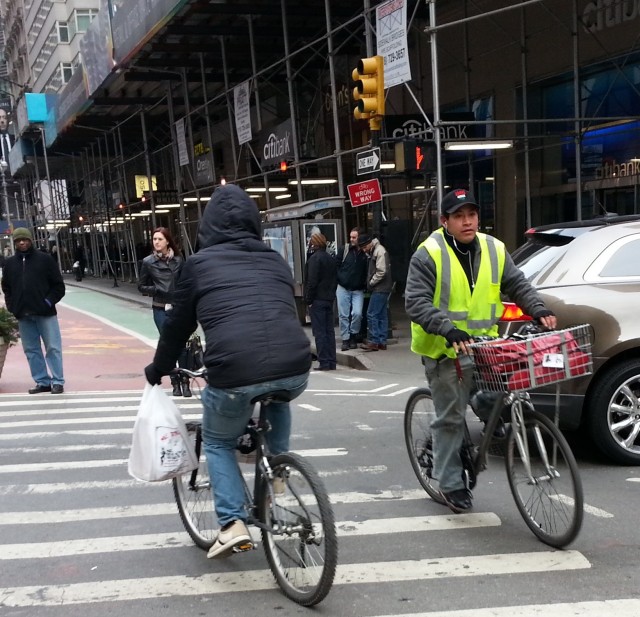
In 1987 Mayor Ed Koch tried to ban cyclists from a swath of Midtown Manhattan. At that time it was bike messengers who got the rap in the so-called bike wars. Today, it’s the food delivery cyclists.
The city is not trying to ban them from riding anywhere. But one frequent complaint about bike lanes stems from a fear of bicyclists riding the wrong way and blindsiding a pedestrian.
One reason the fear often focuses on food cyclists is that deliverymen “are a huge proportion of cyclists on the road,” according to Lisa Sladkus of Upper West Side Streets Renaissance Campaign.
Environmental economist and cycling advocate Charles Komanoff created a study of bike trends using data from the Department of Transportation and elsewhere. It found that between 1985 and 2011, the number of bike messengers in the city dropped from 5000 to 1000, whereas food delivery cyclists rose from 500 to 5000.
That is among 179,000 daily cyclists in New York City in 2011, the study found. The percentage is small, but whereas noncommercial cyclists take three daily trips, the average food delivery cyclist makes thirteen deliveries and twenty-two trips daily, the study showed.
One reason for the uneasy passage of the Columbus Avenue bike lane on Feb 6, was that proponents said protected bike lanes (with barriers) reduce cyclist-pedestrian collisions. A Hunter College study in 2011 found that approximately a thousand hospital patients a year are involved in cycling-pedestrian collisions.
This tension comes at a time when the Bloomberg administration is counting down its final days, and, as the New York Times points out (2.13.13), none of Bloomberg’s potential replacements seem as bike-friendly as the mayor.
The city has taken action specifically on food delivery cyclists. Though cycling laws have existed for decades, the DOT launched safety campaigns for food delivery cyclists last year. Last summer it launched a six-person “commercial cyclist outreach and enforcement unit.” And this year the it will start enforcing laws that involve wearing reflective vests, ID numbers on the chest, and of course, riding the right way, off the sidewalks, and stopping at red lights.
But the New York of Mayor Bloomberg and DOT Commissioner Sadik-Kahn does not appear likely to ever ban cycling anywhere. In fact, in writing, part of the Mayor’s PlaNYC 2030 is to “make bicycling safer and more convenient” as part of its “sustainable transportation” list.
Koch’s plan to ban cycling on Fifth, Madison and Park never materialized. Messengers and supporters daily protested by riding in Midtown before it could go through, and the state Supreme Court killed the plan for what Komanoff, in a historical essay called a “technicality”: the city hadn’t published official notice on time. The city didn’t bother trying again.
But times have not changed as much as it may seem. In order for the city to expand its bike infrastructure, community boards have to accept proposals by DOT, which isn’t granted. Food delivery cyclists are one reason.
In winning over support, the messengers may have had an advantage that food delivery cyclists don’t. Komanoff said the messengers had a way of winning over support because of a “cool factor.”
“In some way that cool factor kind of coexisted in the resistance and paranoia that was stirred up by the media and was exacerbated by the fact that the messengers would go fast and would go aggressively.”
The messengers, many of whom were minorities just as the food-delivery cyclists are, were seen as sub-cultural young people with a kind of bravado, he said. “They had a whole pride in their bike and what they did. And I think that to some extent that was an important aspect of the way New Yorkers reacted [to them] in the ’80s,” he said.
Without that kind of cultural aesthetic protection, food delivery cyclists are more vulnerable to criticism, said Komanoff. From the ’80s into the ’90s, he said, there were bike messenger zines. “It is really hard to imagine there ever being a zine about food delivery cycling,” he said. “And I think that that lack of a positive culture makes it easier for the average New Yorker to write these guys off as different, as alien, as the ‘other.'” Hollywood confirms Komanoff’s point: both Kevin Bacon and Joseph Gordon-Levitt have starred in films as bike messengers.
While there is no hard data distinguishing food delivery cyclists in safety statistics, a single count was done for this piece. On a one-way avenue with a protected bike lane, in a two-block section of Manhattan, forty-three cyclists were counted in thirty minutes around 2 p.m. Food delivery cyclists were identified as those carrying food delivery bags or wearing reflective vests and ID numbers. Five of 25 food delivery-identified cyclists rode the wrong way. Three of 18 non-food-delivery-identified cyclists rode the wrong way. Some of those may have been messengers.
(Correction added: number of messengers reduced to 1000, not 100. Thanks to C. Komanoff for catching the typo.)